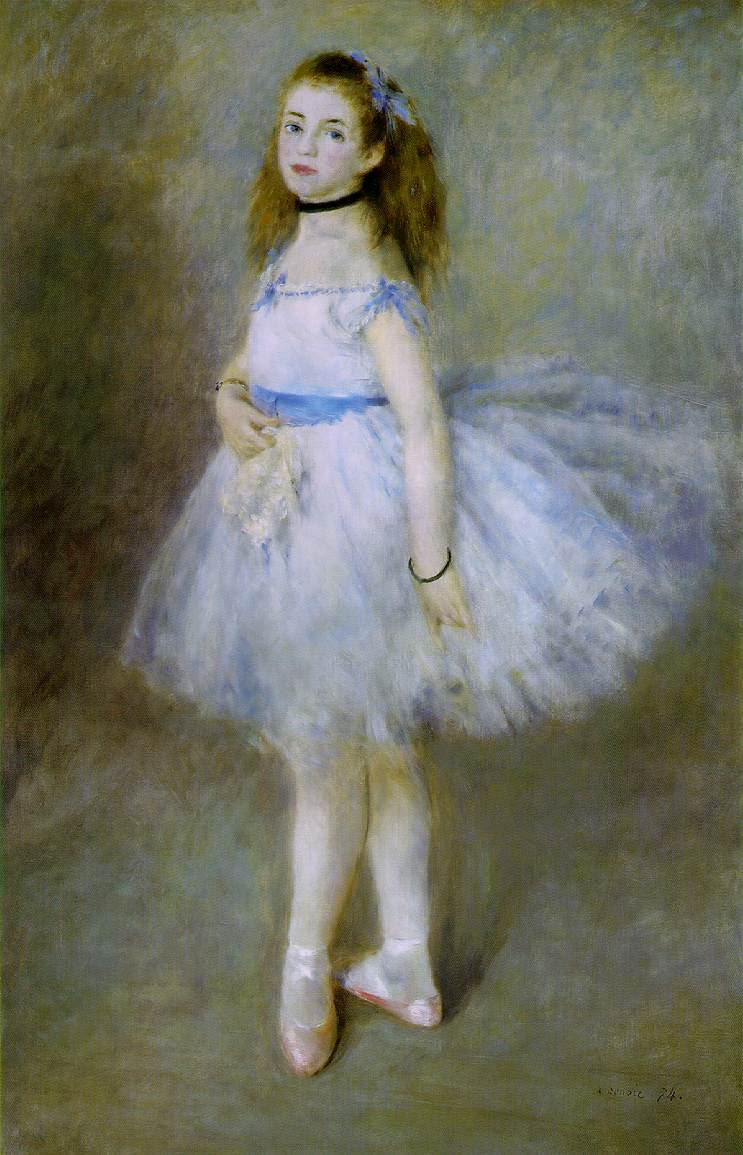art-Renoir.com
Auguste Renoir 1841-1919
Auguste Renoir - Dancer 1874
 Dancer |
From National Gallery of Art, Washingon:
The Dancer was one of seven works that Renoir included in the first exhibition of the Société anonyme coopérative des artistes, peintres, sculpteurs, graveurs, etc., which opened in April 1874. In contrast to works by most of the other artists in the group—soon to be dubbed the impressionists—Renoir's paintings were relatively well received. The Dancer in particular was singled out for attention. While some dismissed it as being little more than a sketch and lacking in good draftsmanship (the same criticisms leveled at many of the works on display), others found it graceful and charming, praising its realism and originality of conception. As one writer remarked, "The Danseuse is true to life and has a fine and nervous elegance in its truth." Another admired the dancer's head, which he described as "fresh, alive, with a very simple modeling and a very accurate bearing."
The Dancer inevitably calls to mind the work of Renoir's fellow impressionist Edgar Degas, whose name is now synonymous with depictions of ballet dancers. In contrast to Degas, whose interest lay in depicting dancers in repose, captured in unguarded and unselfconscious moments, Renoir chose to paint a more formal portrait. Both the painting's scale and the figure's prominence (placed in the very center of the composition, she dominates the entire canvas) hark back to traditional portraits, lending this work a gravity somewhat at odds with the painting's modern subject. Shown in profile, her silk-slippered feet placed in classic fifth position, Renoir's dancer is poised and alert as she turns her gaze toward the viewer. Renoir accentuated the dancer's youth, highlighting the roundness of her face, the still boyish flatness of her chest, even the way the fingers of her left hand appear to toy nervously with tulle of her skirt.
Although Renoir himself never identified the figure, the model is almost certainly Henriette Henriot, the young actress who posed regularly for the artist in the mid-1870s and whose likeness was featured in La Parisienne (National Museum of Wales, Cardiff), another large-scale painting shown by Renoir in the 1874 exhibition. Renoir skillfully transformed his model's appearance, depicting her with equal verve as both a sweet-faced adolescent on the verge of adulthood and a fashionable performer.
Ultimately, however, Renoir's virtuoso brushwork is the painting's most compelling feature. His paint handling is varied, ranging from the delicate brushstrokes that define the dancer's face to the loose, almost careless application of paint in the picture's background. The dancer's skirt is a true tour de force; Renoir masterfully captured the gauzy softness of the tulle. It floats about her body like a cloud, seeming to dissolve into the hazy background, the fabric as light and insubstantial as mist.
Four years after appearing in this historic exhibition, The Dancer was purchased by Charles-Henri Deudon, who amassed a small but important collection of impressionist paintings. In addition to this work, Deudon would go on to acquire five more paintings by Renoir as well as Manet's Plum Brandy.